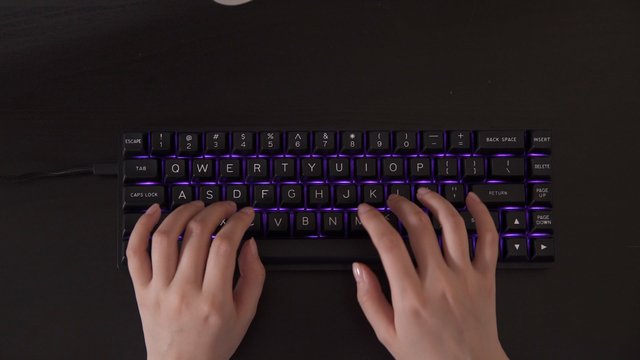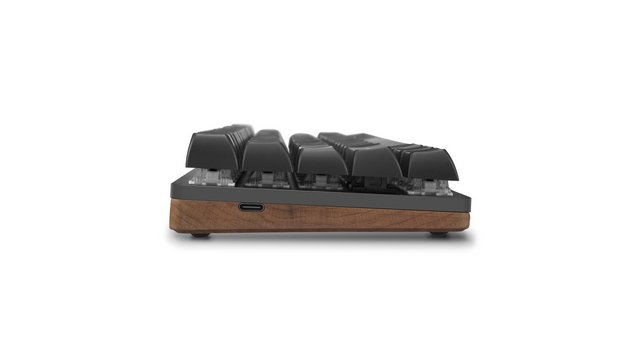I spend all day typing, and when I’m not writing, I’m usually playing a game on PC to write about. Since I make my living by typing, I’m particular in what I want out of a keyboard. Many keyboards just don’t make the cut. They’re too big, uncomfortable to use for long periods of time, or can’t withstand the demands of almost constant use. This is especially true of compact products.
Many 65% layout keyboards are designed for light use with a tablet and don’t have the quality or comfort I’m looking for. When Unick Invent approached me about reviewing their Woo-dy mechanical keyboard available now on IndieGoGo(), I was skeptical. Most 67-key units I’ve tried either fell short of what they promised or cost an arm and a leg. So, confronted with a compact keyboard with a starting retail price of $149 with Gateron Brown (MX Brown clone) switches, a wooden base, and quality construction, I thought maybe I’d finally found the small-form typing solution of my dreams.
Woo-dy Keyboard Review | Design
I love the Woo-dy’s design. The wood base has a timeless appeal and appears to be a singular carved piece. It’s married to a piece of machined aluminum, which gives the unit excellent rigidity. Just lifting the keyboard out of the box, you get a feeling of quality, and there’s no creaking plastic or flex here.
The 67-keys included with the Woo-dy are made from ABS and are black with the lettering in cream. It’s a small thing, but I really loved the font used on the default Woo-dy keys. It reminds of the lettering on the Commodore 64 keyboard and gives a slightly retro aesthetic that matches well with the wood base.
The keycaps also have a spherical shape instead of just a curve. This helps naturally center your fingers when pressing the keys. If they aren’t your style, though, the Woo-dy can take any Cherry MX-compatible keycaps. The switches are also hot-swappable, so you can just quickly pull them and insert new ones of your choice without any significant disassembly of the keyboard.
The review unit I got is equipped with Gateon Brown switches, which have a definite feeling of activation without being too clicky. They strike a good balance between the definitive clack of the Blues and the instant activation of the Reds. These switches, coupled with the wood base, give a much lighter feel when depressing a key than I’ve experienced with similarly equipped units with a plastic or metal underside.
Unick also adds another nice touch in that they lube the stabilizers on the larger keys like backspace, space, and shift. Especially on the spacebar, this results in a much lower impact feel than on most pre-built mechanical keyboards and helps with sound deadening. I’m pretty harsh on my spacebars, and I’m used to them punctuating my typing with a constant sharp clack. With the Woo-dy, this has been eliminated, and I can see this small touch resulting in less wear on the keyboard and my thumbs.
Woo-dy Keyboard Review | Software
It just wouldn’t feel right if the Woo-dy didn’t have some sweet RGB. In the software, you can choose from presets or build your own custom lighting effects. Each key can be individually programmed, and the capabilities of the Woo-dy are on par with Razer’s Chroma or Asus’s Aura RGB solutions.
The software for the Woo-dy is adequate, and unlike that of some other brand’s, it’s stable and usable. The keyboard has built-in memory to save your settings and profiles, so once you get your macros, keymapping, shortcuts, and RGB routines set, you don’t have to worry about continually running the program in the background.
Woo-dy Keyboard Review | Connectivity
The Woo-dy connects to a device in one of two ways. Either you can use a USB-C cable to physically wire it, or you can utilize the built-in Bluetooth. All models of the Woo-dy have Bluetooth, but not every one comes with a battery. That means that even if you go with the cheaper model ($149 vs. $179 for the cherry model), you could hook it up to an external battery and still utilize the Bluetooth functionality.
Using Bluetooth on the Woo-dy is a bit confusing as there’s no dedicated switch to change from wired to Bluetooth mode. Instead, you have to use a key combination to turn on the function and pair it. I would have liked to have seen a separate switch and indicators for the Bluetooth functionality. Additionally, you have to remember to turn off Bluetooth when you’re done by again using a key combination. Sometimes the combo didn’t seem to register for me, and I’d have to try several times to get the keyboard to respond.
Woo-dy Keyboard Review | Bottom Line
I’m delighted with the time I’ve spent with the Woo-dy keyboard. The compact design gives me a lot more room on my desk, and I still get all the benefits of having a high-quality mechanical keyboard. I sometimes do miss the num pad, but I’m finding myself more attached to the 65% layout than I thought I would be.
For an unknown company whose first product was on Kickstarter, Unick Invent has done a smashing job of designing the Woo-dy. Qualms with the Bluetooth function beside, I think this keyboard can stand toe-to-toe with the likes of Roccat, Razer, and Logitech.














